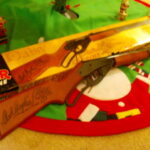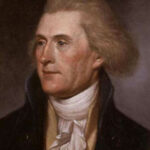Lewis and Clark brought an airgun on the Voyage of Discovery. When this fact became widely known after World War II, while air rifle manufacturers were mass producing and marketing inexpensive models for boys throughout America, the revelation seemed profound. A pellet rifle? A BB gun on that famous expedition by Thomas Jefferson’s Corps of Discovery? Well, not exactly. The airgun Lewis and Clark brought along was a powerful weapon, hardly a Daisy Red Ryder.
Meriwether Lewis was appropriated $2,500 by President Thomas Jefferson to prepare and outfit the party. One of his first orders of business was rounding up firearms to hunt game and provide defense against any hostile tribes that might be encountered. For that role, reliable arms were procured: 15 rifled muzzle loaders. To fire these weapons, Lewis bought 500 flints, 420 pounds of lead, and 176 pounds of gunpowder. But also in the articles supplying the expedition, Lewis included an “air gun.” The weapon is mentioned almost 40 times in the journals kept by expedition members.
In years since, historians have pieced together what seems a reasonable rationale for the airgun’s inclusion. A rarity among American audiences, the device was even more exotic to natives the party met. Its primary purpose was not necessarily for taking game or self defense, although the weapon could surely kill. Rather, in the several times the airgun is mentioned in Lewis and Clark’s journals, it was mainly in reference to impressing the natives.
Typically, meeting tribes along the route followed a certain protocol. Elders would meet with Lewis and Clark’s party and trade pleasantries. Gifts were exchanged, dances performed, and general bonhomie ensued. Then, Lewis would take out the airgun and shoot several times at a nearby target such as a tree. Invariably, the Indians were highly impressed. A repeating firearm was unheard of in those days. Here was a gun that could fire many shots without tedious reloading, and without the flash-bang long associated with muzzle loaders. This technological wonder would stump the native audiences, who could not figure out how it worked. They were never shown the tedious pumping required to fill the gun’s air reservoir, thus it appeared to shoot by “magic.
The gun served to dissuade attack. Indians knew rifles of the day were good for one shot. After that a gunman needed at least a minute, sometimes longer, to reload. Thus, when attacking, Indians would wait until all guns had been fired off, then rush the party. By showing the tribes he had a repeating firearm that worked without gunpowder, and hinting several more were back onboard the boats, Lewis put the elders on notice that standard attacks against his party would not work.
Only one entry in the party’s journals indicates the gun was ever intentioned with anything other than impressing crowds. Shortly after he was accidentally shot in the buttocks (by the one-eyed Pierre Cruzzat who apparently mistook him for game), Lewis thought the party was under attack and suspected insurmountable odds. He wrote of running back to the boat where he gathered his pistol, rifle, and airgun, and prepared to “sell my life as deerly as possible.
That Lewis’ airgun was included in his last ditch arsenal is not surprising. A previous event showed the potential lethality of the weapon. At the journey’s outset, the expedition stopped at Bruno’s Island near Pittsburgh in August, 1803. There, a spectator asked to try out the strange weapon. The gun discharged accidentally, probably because the spectator was unfamiliar with its operation. A woman standing about 40 yards away was shot in the head by the errant round. She went down instantly, blood everywhere. Lewis wrote later everybody thought she was dead. Fortunately the shot only grazed her head, creasing her skin but not penetrating the skull.
Other journal entries note Indians marveled at how deep lead balls from the airgun would sink into trees. The gun was also loud. Anyone shooting a modern pre-charged pneumatic can attest to its loud report as the compressed air pops out the barrel. Lewis apparently dry-fired the gun to signal party members without wasting black powder.
After the midpoint of the last century, vintage airgun collecting took off as a serious hobby. About the same time, interest in the Lewis and Clark expedition through the Louisiana Purchase and the Northwest increased. In due course, as knowledge of the weapon spread, finding it among the few remaining models from the era became the vintage airgun field’s holy grail.
Many early 19th Century American airguns, what few were made, had spherical air reservoirs fitted under the stock. These models could shoot at most a dozen rounds before their compressed air depleted. However, accounts of the day noted that Lewis could shoot about 40 rounds out of his before having to pump it back up. Eventually, after pouring through contemporary accounts of the gun, historians and collectors came to agreement: Lewis must have had a Girandoni airgun. No other model could perform so well.
Bartholomäus Girandoni, a Tyrolean clockmaker and firearms inventor, set out in the late 18th Century to make a better rifle. Loading and firing guns were tedious for soldiers in the Napoleonic era, and efforts at speeding up rates of fire were a constant challenge for inventors. Girandoni’s approach was to turn to air power in designing a repeating weapon. Shooting projectiles with compressed air is actually an old idea, dating at least to Ancient Greek and Egyptian times. Blow darts have been around even longer. But Girandoni’s experience with the fine art of making clocks prepared him for designing a particularly effective pneumatic weapon.
Rather than using a sphere placed under the gun, Girandoni used a butt stock air reservoir that could be pumped up by hand several hundred times to achieve astonishing PSI levels. He designed intricate parts that could effectively channel bursts of compressed air, allowing a good two dozen powerful shots before range and velocity were significantly reduced (and perhaps double that amount until all air in the gun was depleted). Fully pumped up, the gun could shoot 20 – 22 balls from a gravity-fed tube in quick succession. Emperor Joseph II was sufficiently impressed to order 1,500 models for the Austrian army, along with spare reservoirs and ammo tubes.
Alas, the Austrians soon abandoned the idea of using airguns in warfare. Intricate, hard to mass produce, and difficult to use consistently in the heat of battle, the gun was ahead of its time and too complex for dependable military applications. The training required for soldiers to use the weapon was extensive, the guns proved much more fragile in the field than traditional black powder models, and keeping a supply of pre-charged units ready for combat proved a vexing dilemma.
Girandoni’s invention was much better suited for the civilian market where, unlike on the battlefield, casual users would not have to rely on the gun and its strange operating quirks with their lives at stake. Several Girandoni military models quietly made their way through the grey market despite edicts opposing civilian sales. Evidently, one found its way to the U.S. and into Lewis’ hands by 1803.
How Lewis came across the airgun is something of a mystery. Some tantalizing clues center on Isaiah Lukens’ clock shop in Philadelphia. There, young airgun enthusiasts were busy building early American prototypes as a sideline to the clock business, and would have welcomed models from abroad to study for design ideas. The superior European model must have made an impression on Lewis, who recognized the intimidation factor it could offer when properly demonstrated, firing multiple shots without gunfire or muzzle loading.
Wherever Lewis procured the gun, after returning from the voyage it seems possible he returned it to the Lukens shop, perhaps for repairs. A curious record surfaced concerning an estate auction for Lukens in 1847, which indicated an airgun used by Lewis and Clark was part of the sale. Evidently the item was withdrawn before the auction, and there the trail ran cold for over a hundred years.
In 1975, legendary airgun businessman, collector, and historian Robert Beeman and his wife purchased a Girandoni military model airgun, ca. 1798, from a private American antique firearms collector. The “Beeman Girandoni,” as it came to be known, was placed in the private airgun museum run by the couple at their facility in California.
As interest in vintage airguns and the Lewis and Clark expedition continued to grow over the ensuing years, Beeman discounted the idea that his Girandoni was the airgun taken along by the Corps of Discovery, though evidence increasingly pointed in that direction. There simply were not many likely airguns from the era, and his was one of the few.
For many years, a model known to have been created by Lukens, which ended up in the firearms collection at Virginia Military Institute, was widely considered a more likely candidate. But doubts remained. Accounts of Lewis’ gun indicated a round capacity of at least 20, and the ability to fire about 40 shots before recharging. The Lukens model was capable of about half those figures. Still, VMI’s gun seemed the best candidate to many experts.
Then, an interesting series of incidents led to some remarkable conclusions. Ernest Cowan and Richard Keller, a pair of antique gun reproduction and historical experts, became interested in handcrafting an exact copy of the Girandoni airgun used by the Austrian military at the end of the 19th Century. After investigating with their European counterparts, they found that the only model known to be in North America was in the Beeman Collection. They contacted the Beemans and ask to borrow it for a while. In return the Beemans would receive a working museum-quality replica. The Beemans agreed to the deal, and handed the gun over to be taken apart and thoroughly examined.
Right away, Cowan and Keller realized descriptions of the Lewis and Clark airgun and the Girandoni matched up remarkably well. Damage the Beeman model had suffered correlated with accounts in expedition journals. Repairs Lewis wrote of, such as replacing the front sights, seemed to match. But after taking the gun apart, the pair made a profound discovery: the mainspring had been repaired at some point. And the repair was old.
On a trip in the wild such as the Voyage of Discovery, few party members are more valuable than a jack of all trades. Such a man was John Shields, handy at blacksmithing and guns. In early June, 1805, Lewis wrote in his journal that Shields had repaired the airgun’s mainspring. Intriguingly, Cowan and Keller discovered the replaced mainspring in the Beeman Girandoni had been fashioned with a farrier’s file, identifiable by the distinct pattern it leaves on the metal. Had the repair been made in a traditional blacksmith’s shop, such a tool would likely not have been used as it was designed for horse shoes rather than the intricate parts found in a gun.
The crude but effective repaired mainspring, combined with other damage consistent with journal accounts and the documented capabilities of the gun confirmed by researchers, led to something rare among historical experts: consensus. No expert in the field doubted any longer that the Girandoni obtained by the Beemans is almost certainly the same airgun taken by Lewis and Clark on the Voyage of Discovery. It remains one of the few artifacts conclusively linked to that historic journey.
Technically, the Lewis and Clark Expedition was a military endeavor. In light of the historic significance of this particular weapon, officials at the U.S. Army Heritage and Education Center, a component of the U.S. Army War College at Carlisle Barracks, Pennsylvania, requested the Beemans donate the gun so that it could be displayed at the Army Heritage Museum. The Beemans formally donated their Girandoni to the U.S. Army in a public ceremony on May 18, 2007. The airgun now resides heavily safeguarded at the museum, and is widely considered the single most important gun in U.S. history.
Sources:
http://www.beemans.net/lewis-assault-rifle.htm
http://www.pbs.org/lewisandclark/inside/idx_equ.html
http://www.lewis-clark.org/content/content-channel.asp?ChannelID=300





